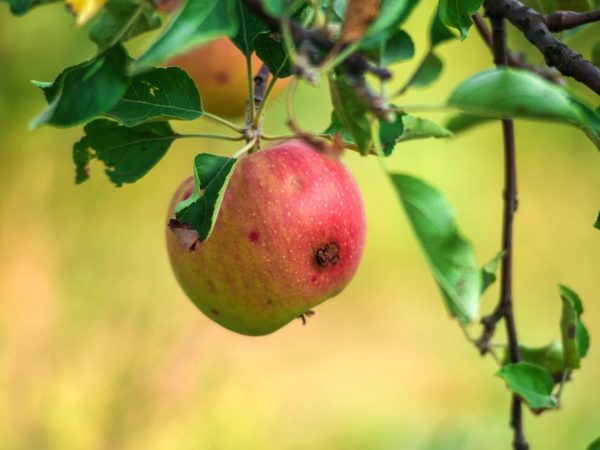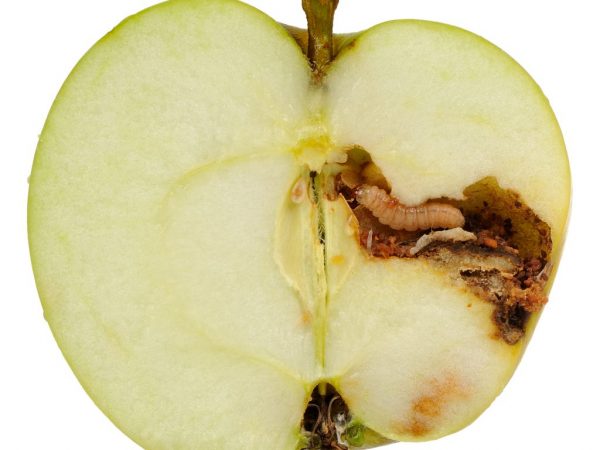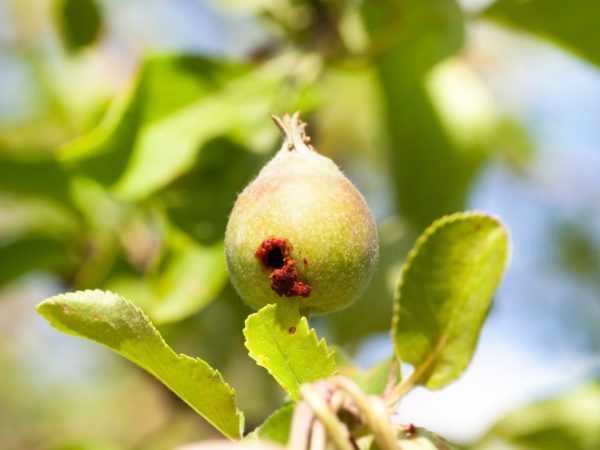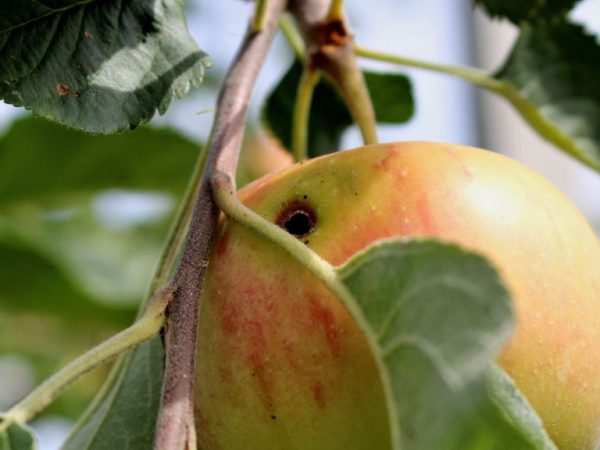Reasons for the appearance of wormy apples
The wormy apple is the result of an attack by a moth. The butterfly, inconspicuous in appearance, is distributed throughout the European region of Russia, with the exception of the tundra zone. It is found in the Caucasus, the Far East, Central Asia and Siberia, in Altai and in Transbaikalia.
- Description of the moth
- Harm inflicted
- What are the caterpillars
- Varieties
- When to process trees
- Early spring
- At the end of flowering
- At the stage of fruit ripening
- Autumn
- Using folk remedies
- Tobacco
- Sagebrush
- Pepper
- Tomato
- Environmental practices
- Trapping belt
- Pheromone trap
- Biologicals
- Natural enemies
- Use of chemicals
- Atom
- Zolon
- Iskra M
- Ivanhoe
- Sumi Alpha
- Prophylaxis

Reasons for the appearance of wormy apples
Description of the moth
The moth is a small insect that looks a bit like a butterfly. At a wingspan of 20 mm, it is nocturnal and settles on various fruit trees, as well as on bark and leaves. The specific color, merging with the color of the tree bark and branches, allows it to hide from natural enemies.
The main activity falls on the flowering stage of horticultural crops and covers 1.5-2 months.
During this period, the pest is able to lay up to hundreds of eggs, from which larvae with a black head hatch. It is they who do the main harm to horticultural crops, affecting the ovaries.
Today in agriculture there are no varieties that are absolutely resistant to the attack of the moth.
Harm inflicted
Black caterpillars (or worms) feed on vegetative parts of fruit trees for 0.5-1.5 months, after which they hide in tree bark or in soil for pupation and subsequent egg deposition.
Through the petiole and lesions on the peel, they gnaw through the surface of the fruit and penetrate inside (the pulp is their main food). In this place, a focus of rot is formed, which is produced by a bacterial pathogen. Decaying fruits become the object of attracting wasps.
Fruits with sweet pulp are in a special risk group. Apples of the juice direction are less susceptible.
Wormy and rotten fruits fall prematurely. In this case, one individual is able to spoil up to 5 fruits.
In case of mass defeat, up to 3/4 of the entire crop is destroyed. Therefore, it is necessary to take measures to save the garden as soon as possible.
What are the caterpillars
Over the entire life cycle of the moth, several generations of caterpillars appear:
- The 1st generation begins to appear from the last days of May (in the northern regions) and already at the beginning of May (in the southern regions), the period lasts until the last days of June;
- the appearance of the 2nd generation falls on the end of July - August;
- The 3rd generation often does not have time to pupate and remains for the winter in fallen leaves or containers for storage of fruits and in storage rooms, when heated to 10 ° C, butterflies emerge from overwintered cocoons, and their life cycle begins anew.
In the southern regions with a stable warm climate, the number of caterpillars hatched by the moth reaches 4-5.
The greatest danger to horticultural crops is posed by the second generation of caterpillars, destroying up to 80-90% of the crop.For comparison: the first pests that appear are capable of infecting up to 25% of fruits.
Varieties

Caterpillars can destroy almost all crops
Depending on the trees on which the moth settles, it is conventionally divided into apple, pear and plum. The latter pest also affects apricot, peach, quince, etc.
They differ in color from each other:
- the apple moth has a dark gray color, decorated with transverse wavy lines;
- in color, pear is slightly darker than apple;
- the plum moth has a purple tint in color.
When to process trees
In each region, the timing of the treatments of apple, plum, pear, apricot, sweet cherry and peach against the moth differs and depends on the climate.
- In the southern part of Ukraine, in the Volga region, Rostov region and Stavropol, they begin to fight the pest 2 weeks after the end of the flowering stage of fruit trees, repeating preventive measures 2 weeks later when the first caterpillars appear;
- In the North Caucasus, in the southern part of the Lower Volga region and the Krasnodar region, they firstly spray trees and cultivate the soil 1.5 weeks after their flowering, repeating the procedure after 3 weeks, then at the first signs of revitalization of caterpillars and, if necessary, again after 2 -3 weeks.
Additional spraying to protect the orchard is required only with a massive outbreak. They are used only for winter varieties.
Early spring
To get rid of the caterpillar on the leaves of the apple tree, in early spring, they are treated with preparations containing phosphorus. They allow you to kill butterflies at the stage of their birth.
At the end of flowering
After the end of the flowering stage, the massive years of the pest are celebrated, therefore this is the time for the use of pesticides. Such chemical compositions make it possible to destroy not only adults, but also their larvae.
At the stage of fruit ripening
They try to use less toxic drugs and pheromone traps, spray them with decoctions of herbs that repel butterflies, and biological preparations that do not harm ripening fruits.
Autumn
After the foliage has fallen, in the fall, pesticides are used to combat the apple moth, which effectively cleanse the garden of the remaining adults and the eggs laid by them.
At the same time, in the fall, tree leaves are sprayed with poisonous preparations, and the trunks and branches are cleaned with scrapers.
Using folk remedies
Traditional methods of dealing with caterpillars on an apple tree are used at the stage of development of fruit crops, when the use of pesticides is not permissible and can harm the tree or ripening fruits, including:
- at the stage of fruit setting;
- during the period of active fruiting;
- during the ripening period of early and mid-season varieties.
Tobacco

Insects can be fought with folk remedies.
You will need 250 g of dry tobacco mixture, 10 liters of water and 25 g of laundry soap.
Tobacco is diluted in water and kept for 2 days, then boiled for 2 hours and the volume of liquid is increased by 10 liters of water.
Just before use, for better adhesion to the leaves and bark, add grated soap.
Sagebrush
Wormwood (1 kg) is boiled for half an hour, cooled and the volume of liquid is increased by 10 liters of water.
Pepper
A solution for processing an apple tree is prepared from 250 g of chilli peppers and 1 liter of water.
The mixture is boiled for 1 hour, kept for 2 days and filtered. The working solution is prepared from the prepared concentrate by diluting 500 ml in 10 liters of water.
Immediately before use, grated soap is added to it (for better adhesion to the leaves and bark).
Tomato
The garden culture is treated with a solution of tomato roots, tops and fruits. All ingredients are crushed and diluted with water in a ratio of 2: 5, boiled for 0.5 h, filtered.
The working fluid is made from the prepared concentrate, diluting 3 liters in 10 liters of water.
Immediately before use, grated soap is added to it (for better adhesion to the leaves and bark).
For this protection method, tomato tops can be replaced with potato tops.
Environmental practices
The apple moth is also being destroyed ecologically. Moreover, such methods have the least harm to the culture.
The most effective are the trapping belt, pheromone trap and insecticides with biological compounds. Also, to combat the pest, its natural enemies are attracted.
Trapping belt
Gardeners make their own fishing belt from a piece of paper, fabric or burlap, cutting strips 25-30 cm long. They tie the trunk of a fruit tree at a distance of 0.3-0.4 m from the surface of the earth, fixing the trapping belt from above with twine and leaving the lower edge free.
To increase the efficiency of the belt, it is possible to coat it in the lower part with caterpillar glue or a composition with a pesticide.
A glue mixture or medical petroleum jelly is suitable as a coating. It is permissible to prepare the glue mixture on your own from resin, rosin, paraffin and garden varnish, taken in proportions, respectively, 10: 1.5: 1.5: 2. All ingredients are mixed and heated over low heat until they become a paste.

Apple trees can be protected from the moth
This technique is a mechanical method capable of protecting against the moth and requires constant cleaning of the strips from caterpillars that regularly fall under the trapping belt in the process of climbing up the trunk.
The exception is those belts that are treated with pesticides for protection. There is no need for regular inspection. It is enough to soak them every 10-12 days.
Pheromone trap
Environmentally friendly traps are based on pheromone concentrate - a volatile substance with high physiological activity, which acts as a means of attracting males.
They slow down and prevent the intensive reproduction process of the insect. In the natural environment, the effectiveness of the action lasts for 1-1.5 months.
This method of dealing with the apple moth is suitable for determining the stage of appearance of butterflies: if more than 5 individuals fall into 1 trap, they begin to use other processing means.
Biologicals
The apple moth is destroyed by Fermo-Virin, Bitoxibacillin or Lepidocide.
The advantage of these drugs is the ability to process the garden at the stage of the growing season without limiting the number of procedures at weekly intervals.
Natural enemies
Various species of tits, flycatchers and sparrows peck up moth caterpillars en masse. To attract birds to the garden, feeders are hung with an air hole of 3-4 cm.
Use of chemicals
Apple trees are also sprayed with synthetic pesticides, which contain organophosphorus compounds, as well as compounds with neonicotinoids and pyrethroids.
Chemicals are applied before and directly at the flowering stage, followed by a repeat after 2 weeks and after harvesting the fruit.
Atom
The toxic chemical is produced in the form of an emulsion, has a wide range of effects.
The standard of use is 5 ml of the preparation for 10 liters of water for every 100 m².
The frequency of application is 2 times per growing season, no later than 30 days before the planned harvest date. It is toxic to bees, therefore it is not used near apiaries.
Zolon
The ash is released as a liquid.

Use special pest control products
Usage rate (per 100 m²) in 10 liters of water add the required amount of the drug:
- 8 ml each - for apple trees;
- 25 ml each - for plums, pears, apricots, cherries;
- 14 ml each - for peaches.;
The frequency of application is 2 times per growing season, no later than 40 days before the planned harvest date. It is toxic to fish, not applicable in water protection areas.
Iskra M
Iskra-M contains malathion, is produced in the form of an emulsion (volume 5 ml or 10 ml).
Usage standard: for 100 m², 10 liters of solution (the drug is diluted with water in a ratio of 1: 1000).
Frequency of application: 2 times during the growing season, before the beginning of the flowering stage and after harvesting.
Ivanhoe
Pyrethroid Ivanhoe is resistant to moisture and is not washed off by precipitation.
Usage standard (for 200 m²): for 10 liters of water, 10 ml of the preparation. The frequency of application is 2 times per growing season.
It is not toxic to bees, it can be used near apiaries.
Sumi Alpha
Pyrethroid Sumi-Alpha is intended for spraying apples, pears, plums and apricots.
Usage standard (per 100 m²): 5 ml of the drug per 10 liters of water. The frequency of application is several times during the growing season with an interval of 3 weeks, no later than 14 days before the planned harvest date.
Prophylaxis
There are many remedies for black caterpillars, but it is best to deal with them beforehand: preventive measures reliably protect the apple tree and other fruit trees.
- Regular and thorough digging of soil after the fruit and berry period, especially in the area of the tree trunk circle. Such a procedure in the fall allows you to get rid of the caterpillar cocoons preserved in the ground.
- Removal of plant debris from the garden area, where caterpillars winter.
- Cleaning of tree bark during autumn care and preparation of horticultural crops for winter, followed by burning of the removed bark.
- Regular selection of volunteers.
- Planting around the perimeter of the orchard of plants that scare off moth butterflies (tomatoes, dill, mustard).



